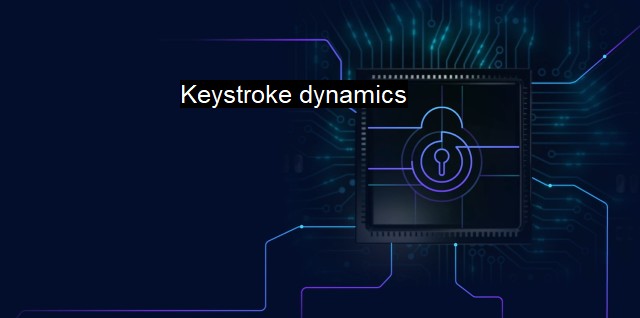What are Keystroke dynamics?
Keystroke Dynamics: An Effective Biometric Authentication Method for Preventing Identity Theft and Cyber Fraud.
Keystroke dynamics refers to the identification methodologies used to study the typing rhythms and patterns of individuals as part of biometric authentication. The method being utilized for recognising individuals based on habitual rhythm patterns in the way they type characters on a keyboard. It is also known as typing dynamics and is recognized as an effective behavioral biometric technique to ensure data security and privacy.In the modern era where everything is gradually moving towards digitisation comparable to the cybersecurity and antivirus industry, keystroke dynamics plays a significant role. The primary objective of using keystroke dynamics is to prevent unauthorized access to systems and sensitive data by creating unique typing patterns that are very difficult, if not impossible, to mimic.
The mechanics behind keystroke dynamics is based on the theory that each individual has a unique typing style. This unique style of typing is captured through two essential metrics: 'dwell time' and 'flight time'. Dwell time is the duration for which a key is pressed before being released, whereas flight time refers to the interval between releasing a key and pressing the next one. Together, these metrics are used to build a user's profiling signature that can be measured for access authentication.
This method of cybersecurity underscores the effectiveness of biometric technologies. It simply augments the need of remembering complex passwords by verifying user identity based on their typing patterns, providing an additional layer of security. What sets apart keystroke dynamics from other modes of biometric security is that no additional hardware is required and measurements can be taken on-the-fly as users type.
The use of keystroke dynamics is proliferating across various walks of cybersecurity including securing online banking transactions, system login procedures, and more. What sets it apart from other forms of biometric security, such as fingerprint scanning or facial recognition, is that it is non-intrusive and imperceptible to the user. It suggests that users need not take any additional steps, like positioning their finger on the scanner or standing in front of a camera for facial recognition. They can simply type as they normally would, providing a seamless and unobtrusive user experience.
Adding to its advantages is the inherent nature of keystroke dynamics, making it resilient to having signatures stolen or cloned, unlike other physical biometric traits. Even if a malicious uncompromised threat actor can observe or capture a user's typing habits, replicating that exact timing and rhythm is highly unlikely. Hence, from a security standpoint, keystroke dynamics offers a robust, cost-effective, and user-centric approach.
Use of algorithms and machine learning techniques such as Artificial Neural Network (ANN) composed of artificial neurons or nodes allows for more advanced and precise profiling of users based on their typing patterns. This includes analyzing key pressure intensities and assessing inconsistencies in these patterns, enabling advanced threat detection and response even before a potential security incident occurs.
In the face of increasing cybersecurity threats, companies and organizations are seeking more secure methods to protect sensitive data. Antivirus software are becoming more advanced, cryptography is more widely used but successful hacker attacks show there are loopholes. Keystroke dynamics offer a viable additional layer of security. Especially in context of strong and continuous user authentication, where after initial login, users are verified not just by 'what they know' or 'what they have', but also 'who they are', case in point, by their unique typing pattern.
Keystroke dynamics offers an invaluable tool in the holistic approach to cybersecurity. Incorporating it into the multifaceted strategy of cybersecurity measures provides for an extra level of personalized scales of security, strengthening the overall cybersecurity framework beyond traditional measures. It provides a layered defense approach, marrying seamlessly with other solutions to offer a comprehensive array of protection against an increasingly sophisticated environment of cyber threats. The synergy of keystroke dynamics with antivirus protection and other security measures is both a testament and a catalyst to the advancement of biometric technology in the realm of cybersecurity.

Keystroke dynamics FAQs
What is keystroke dynamics?
Keystroke dynamics refers to the process of analyzing the typing rhythm and pattern of an individual to identify them. It involves capturing and analyzing various keystroke parameters, such as typing speed, pressure, duration, and timing.How does keystroke dynamics work in cybersecurity?
Keystroke dynamics is used in cybersecurity as a biometric authentication method to verify the identity of a user. It can also be used as a behavior-based intrusion detection tool, as it can detect unusual typing patterns that differ from the user's norm.What are the advantages of using keystroke dynamics in cybersecurity?
Keystroke dynamics offers several advantages over traditional authentication methods, such as passwords and PINs. It cannot be easily shared or stolen, it is difficult to fake, and it can provide continuous authentication throughout a user's session.What are the limitations of using keystroke dynamics in cybersecurity?
Keystroke dynamics can be affected by several factors, such as physical and emotional state, fatigue, and distractions, which can lead to false rejections or false acceptances. Additionally, it requires the user's active participation, which may be inconvenient or difficult for some individuals.| | A | | | B | | | C | | | D | | | E | | | F | | | G | | | H | | | I | | | J | | | K | | | L | | | M | |
| | N | | | O | | | P | | | Q | | | R | | | S | | | T | | | U | | | V | | | W | | | X | | | Y | | | Z | |
| | 1 | | | 2 | | | 3 | | | 4 | | | 7 | | | 8 | | |||||||